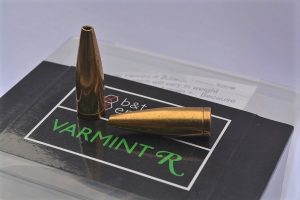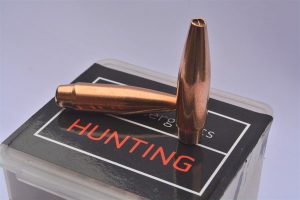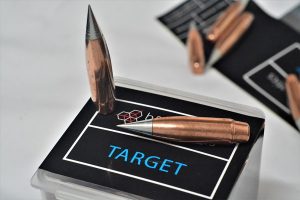There are a few questions that are frequently asked about the Varmint R line of bullets, as they are not of conventional construction. We have answered a few of these below:
Are brass jackets hard on the barrel?
Brass jackets made from rimfire cases are only about .010-.012 inches thick, made of 70% copper and 30% zinc. Most copper jackets are around .018-.022 inches thick, and are made of 5% to 10% zinc with the balance copper. These two facts lower the friction of the rimfire jacket, so that it is actually easier on the barrel than a copper jacket. Zinc reduces friction, and the thin jacket is engraved more easily by the rifling. Higher copper content alloys do not break up on impact as much as the brass jackets, so they make better bullets for edible and dangerous game hunting. Brass jackets tend to break up when they hit the ground, so they make better varmint bullets with greatly reduced richochet potential.
Do brass jackets foul the bore?
Any bullet fouls the bore to some degree. Brass jackets generally causes less fouling than commercial jackets, for a couple of reasons. First, it usually exhibits reduced friction, being thinner and slightly less “gummy” than softer copper alloys. These brass jackets can’t be fired at as high velocities due to the thinness of the jacket, which forces the reloader to use relatively reduced loads for lower velocities, and therefore causes less fouling than a bullet fired at higher speed.
What about the rimfire “dent” from firing?
Cases which have been fired in certain guns with sharp, square edged firing pins may in fact have an actual tear or hole in the edge. These are apparent when we remove the rim from the jacet during swaging, and jackets exhibiting bad tearing are discarded at this point. Most of the rimfire cases will simply be dented at the rim, and the dent is pushed back out again when the rim is removed and the core is seated. You can usually see where the dent was in the final product, but should not cause any meaningful detriment to accuracy.
Are brass jacket bullets accurate?
The answer to this question would be the same as if you ask “Are Sierra bullets accurate?” “Are Hornady bullets accurate?” Sure, but you have to work up the best load for each in any given gun, and some guns may perform slightly better with one brand than another. The short answer is “Yes! Surprisingly accurate.”
Are there any restrictions on using rimfire jacket bullets?
Yes, there are. Because the jackets are thin, the velocity should be reduced to prevent bullet disintegration in flight. Start loading below 3000 fps, and work up until your bullets start to create one or two flyers out of a group of five shots, then back down until you get the tight groups back. Some guns will handle higher velocity than others with the thin jackets. A general rule of thumb is that the limit in a 1-10 barrel twist is somewhere around 3,200 fps, but some shooters have reported good results at higher velocity. The jackets are thin so the bullets open up quickly or even blow apart on impact, making great varmint bullets but poor edible game bullets. Of course, because they are thin, they act as if they impact at far higher velocities than what you would think, saving powder and barrels in the process.



